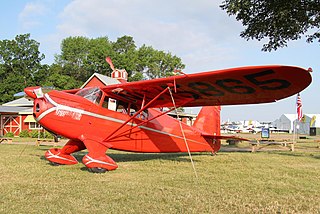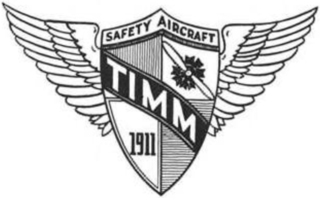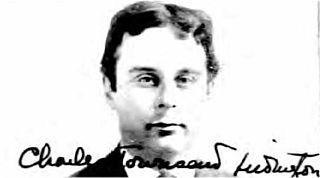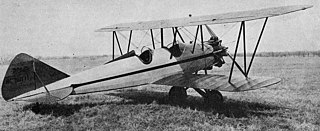
The Aeronca L was a 1930s American cabin monoplane designed and built, in small numbers, by Aeronca Aircraft. It differed significantly from other Aeronca planes by the use of radial engines, streamlining, and a cantilever low wing.

The LeBlond radial engines, later produced under the name Ken-Royce, were a family of 3-cylinder, 5-cylinder and 7-cylinder, air-cooled radial engines for aircraft, built in the 1930s by the LeBlond Aircraft Engine Corporation until the operation was sold to Rearwin Airplanes in 1937 and renamed Ken-Royce Engines.

The Waco Aircraft Company (WACO) was an aircraft manufacturer located in Troy, Ohio, United States. Between 1920 and 1947, the company produced a wide range of civilian biplanes.

The Cessna Model CG-2 was an American primary glider built by the Cessna Aircraft Company in the early 1930s.

The Waco CG-4 was the most widely used American troop/cargo military glider of World War II. It was designated the CG-4A by the United States Army Air Forces, and given the service name Hadrian by the British.

The Commonwealth Skyranger, first produced as the Rearwin Skyranger, was the last design of Rearwin Aircraft before the company was purchased by a new owner and renamed Commonwealth Aircraft. It was a side-by-side, two-seat, high-wing taildragger.

Commonwealth Aircraft Company was an aircraft manufacturer from Valley Stream, New York. Originally Rearwin Aircraft & Engines of Kansas City, the company was renamed in 1942 after it was purchased by a new owner. During World War II, Commonwealth primarily made combat gliders under contract to the Waco Aircraft Company. After World War II, Commonwealth resumed production of the Rearwin-designed Commonwealth Skyranger and consolidated operations in Valley Stream, New York. Commonwealth Aircraft went bankrupt in March 1947 and ceased operations.

The Rearwin Sportster is a 1930s American two-seat, high-winged, cabin monoplane designed and built by Rearwin Aircraft & Engines for sport/touring use.

The Rearwin Cloudster was a two or three-seat civil utility aircraft produced by the Rearwin Aircraft & Engines Company of Kansas City, Missouri beginning in 1939. It was a strut-braced, high-wing monoplane of conventional design with an enclosed cabin and fixed, taildragger undercarriage. One specialized version was produced as a trainer for Pan American Airways.

The Rearwin Junior was a 1930s two-seat high-winged ultra-light monoplane sport aircraft produced in the United States by Rearwin Airplanes Inc. It was part of a trend of extremely low-cost aircraft as manufacturers attempted to survive the Great Depression.

The Rearwin Speedster was a two-seat, high-wing, sport aircraft produced by Rearwin Airplanes Inc. in the United States in the 1930s.

Fairfax Municipal Airport was a Kansas City, Kansas airfield from 1921 that was used during 1935–1949 by the military. Federal land adjacent to the airfield included a WWII B-25 Mitchell plant and modification center and a Military Air Transport terminal. After being used as a Cold War-era Air Force Base, it was used for airliner servicing by TWA and for automobile and jet fighter aircraft production by General Motors, which built a 1985 Fairfax Plant over runways when the municipal airport closed.
Herbert Rawdon was an American aviation pioneer.

LeBlond Aircraft Engine Corporation was a small engine manufacturer incorporated on April 11, 1928. It was located on the northwest corner of Madison and Edwards Roads in Norwood, Ohio It was a subsidiary of the R. K. LeBlond Machine Tool Company in Cincinnati, Ohio, a manufacturer of metal machining lathes.
The Antique Airplane Association, Inc. (AAA) is the oldest antique airplane association in the world. The AAA formed in August 1953 by Robert L. Taylor, via a classified ad in Flying magazine and a few people with a deep-seated interest in old airplanes, for the purpose to fly, to preserve, to share and to promote the early flying machines.
Melvin Eugene Salvay was an American aircraft engineer.

The O.W. Timm Aircraft Company was an American aircraft manufacturer founded by Otto William Timm, based in Los Angeles, California.

Charles Townsend Ludington, , was a businessman of Philadelphia. He was an aviation pioneer who helped establish an every-hour-on-the-hour air service between New York and Washington. His airline ultimately became Eastern Airlines. He designed airports, airplanes, and gliders. One of his designs became a Navy training airplane. Another of his designs was a crash protection device installed on Navy airplanes that saved pilot lives. Ludington also make a line of boats that were designed by a professional outboard boat racer.
Dwane Leon Wallace was an American aviation businessman and aircraft designer. He served as the president and/or chairman of the board of the Cessna Aircraft Company from 1935 until the 1970s, having then continued on the board as a director and consultant into the 1980s. Wallace later became known as the "Quiet Giant of Aviation", and was posthumously inducted into the National Aviation Hall of Fame in 2012. He was included in the Flying Magazine list of the "51 Heroes of Aviation", placing at number 11.

The Rearwin Ken-Royce was an American three-seat sport/touring biplane built by Rearwin Airplanes first in Salina, Kansas then Kansas City. It was the first airplane built by the company.
















